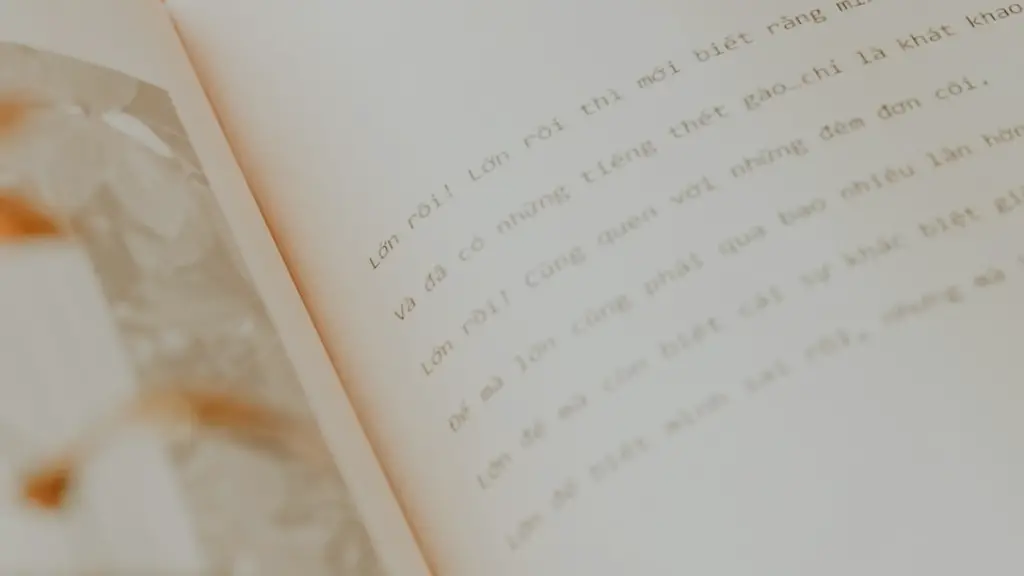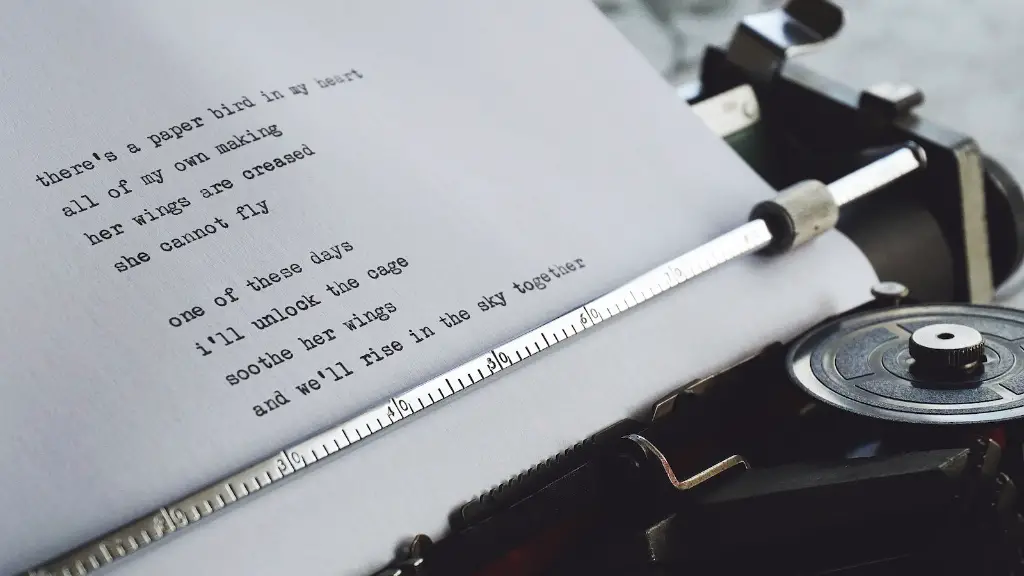Poetry vs Prose
Understanding the differences between poetry and prose can be difficult. Both have a purpose for telling a story, but vary greatly in their delivery. Poetry and prose both have their own rules, conventions, and complexities, which can add to the difficulty of decoding them.
Poetry is usually composed of short lines, often with rhyme and meter, which creates a more musical, rhythmic feel than prose. This contrast is typically created through the use of words with multiple meanings or different tones, metaphors and similes. Poetry can be used to express emotion and ideas, whereas prose is used to tell a story or describe something. Additionally, poetry often conveys meaning and emotion through sparse language and imagery, while prose tends to be longer in length and generally flows in a manner that makes sense.
The difference between poetry and prose can be seen in the structure. Poems often use verse forms, such as odes, sonnets, haikus and blank verse. These structures form the poem in a specific way, allowing the poet to make certain statements and comparisons. Prose does not have a specific structure, instead relying on the writer’s use of literary devices, such as characterization, foreshadowing and symbolism, to create a story or idea.
Generally, poetry is more meaningful than prose as it relies heavily on metaphors and analogies to describe the subject matter. This can allow the reader to make interpretations of the poem that may not be available in a prose piece. Additionally, the structure of poetry allows for more flexibility than prose, which is written in a linear fashion. Because metaphors and other poetic devices are used as a way to communicate ideas, the lines of a poem can become intertwined and complex, something that is not possible with prose.
In conclusion, the main difference between poetry and prose is found in the way they are written. While both can be used to tell stories and communicate ideas, the structure and elements of each are very different. Poetry is usually composed of lines with a specific form and uses metaphors and imagery as a way of conveying emotion and ideas. Prose does not have a specific form, relying instead on the use of literary devices and structure to tell a story.
Nuanced Discussion of Poetic Devices
Different poetic devices must be considered to differentiate between poetry and prose. Meter and rhythm is a prominent feature of poetry, while it is absent in prose. By repeating lines, or writing in a specific pattern, poets can create a unique feeling in the poem that is hard to find in prose. Poetic language also plays an integral part in creating the desired effect. Writers of poetry can use devices such as alliteration, rhyming, puns, hyperboles, and symbols to emphasize their message or create an image in the reader’s mind.
Poems can also be broken into sections such as stanzas and couplets, with the writer either leaving a pause at the end of each line, or continuing the thought onto the next line to acknowledge the end of the stanza. This helps create a flowing structure that can leave a big impression on readers. Prose does not provide this sense of pause and complex structure, instead utilising paragraphs to break up the text.
Syntax is another tool that is used by poets to differentiate their writing from prose. This consists of the writer’s use of phrases, clauses, and words in a specific order to create a specific meaning. By manipulating syntax, a poet can control the flow of their poem, as well as provide additional nuances to the text. This is an essential tool for poets and completely absent in the writing of prose, which instead relies on long sentences.
Finally, writers using poetry are able to make use of several literary devices, such as irony and paradoxes. By using these devices, a poet can create unexpected turns in the poem, as well as showing a deeper level of meaning. While some of these devices are found in prose, they are not used in the same way as in poetry.
Rhetorical Strategies in Poetry vs Prose
The rhetorical strategies used in poetry and prose often differ greatly. Poetry is typically written to evoke an emotion, such as sadness, joy, or anger. Prose, on the other hand, is meant to convey information and ideas in an objective way. Poetry is often ambiguous and open to interpretation, while prose most often has an immediately clear meaning.
Poetry usually contains shorter lines, often with no specific numbers. This allows the poet to draw out individual words or phrases, and achieve a different effect than what might be achieved in prose. For example, the oral quality of poetry allows it to stand out when compared to written prose, as the reader can insert their own interpretation in order to fit the poem. Additionally, the poet can use both irony and metaphor to lend an idea to the poem without writing out the entire concept.
Prose relies more heavily on the use of facts, figures, and exposition. The writer is expected to tell the story in a direct and straightforward manner, without allowing the reader to make interpretations of their own. Writers of prose often have to expand upon the topic in order to give the reader more information, which is not something expected of a poet. Additionally, the writer of prose must be mindful of the structure of their writing, as this can affect the rhythm and flow of the piece.
In conclusion, the main difference between the rhetorical strategies used in poetry and prose is that poetry often relies on ambiguity and imagery to create a feeling or idea, while prose is more direct and factual. Poetic devices such as metaphor, irony, and symbolism can be used to inject a deeper meaning into a poem, while prose must use more direct language. Additionally, the structure of both genres differs greatly, with poetry often breaking into stanzas or couplets and prose using paragraphs.
Exploring the Effects of Metaphors in Poetry and Prose
Metaphors are an important tool for writers of both poetry and prose. A metaphor is a comparison made between two things that is not literally true. This tool allows writers to convey complex ideas in a more creative and vivid manner.
In prose, the writer has more freedom to use the metaphor as a tool to explain or elaborate on an idea. Prose allows the writer to provide context, definitions, and additional information to better explain the metaphor. This can lead to more effective communication, as the reader is not forced to guess the full meaning of a metaphor.
When writing poetry, however, the availability of context and explanation is greatly reduced. The poet must rely heavily on the reader’s understanding of the metaphor in order to convey the desired effect. This can lead to the poem being difficult to understand, but it adds an emotional quality to the work that is not possible in prose.
Metaphors can also be used as dramatic devices in both poetry and prose. In poetry, the metaphor is often used to create a tension between the literal and figurative meanings. This can cause the reader to pause and consider the deeper meaning of the poem, something that is not often possible with prose.
In conclusion, metaphors can be used to great effect in both poetry and prose. The writer of prose can provide more explanation and context for the metaphor, which can lead to more effective communication, while the poet must rely on the understanding of the reader to create their desired effect. Additionally, metaphors can be used as dramatic devices to create a tension between the literal and figurative meanings.
Exploring Poetic Language Tools
Poetic language tools, such as alliteration, simile, and onomatopoeia, are used to convey ideas and emotions in both poetry and prose. Alliteration is the repetition of the same sound at the beginning of two or more words. Simile likens two things and requires the use of “like” or “as”, while onomatopoeia is the use of words to imitate sounds.
Alliteration is a tool very commonly used in both poetry and prose. This tool helps to draw out individual words or phrases, and gives the writing an extra layer of resonance. In prose, alliteration can be used to add emphasis to a point, while in poetry it is often used to create a lyrical effect. Similarly, simile can be used to make a comparison between two things in both prose and poetry, often for the purpose of emphasizing a point.
Onomatopoeia is much more common in poetry than it is in prose. This tool is often used to evoke an emotional response in the reader, as well as create an auditory image in the mind of the reader. It can also be used to draw out verse or add rhythm to a poem, something that is not possible with prose.
In conclusion, poetic language tools are helpful in both poetry and prose. Alliteration, simile and onomatopoeia can all be used to create a desired effect, although these tools will often be used differently in the two genres. Alliteration and simile can be used in both for the purpose of adding emphasis and making comparisons, while onomatopoeia is more often used in poetry for the purpose of evoking an emotional response.
Poetry’s Unique Voice and Tone
The voice and tone of poetry is often very different from prose. Poetry is often written with the intent of conveying more than just information, but rather feeling and emotion. As such, the language used in poetry is likely to be more sparse, yet powerful and evocative.
The poet’s choice of words and imagery can be used to convey a certain tone and atmosphere. The poet can use this to create a sense of awe, anger, or sorrow that cannot be achieved by using prose. The poet is also able to include subtle nuances in the language, which may not be available when using prose. This allows the poet to add further layers of meaning to the poem, and make it more interesting for the reader.
The voice of a poem is also different from that of prose. Poets can often lend a unique emotion to their writing, without needing to directly explain the meaning. This is because they are able to use symbols and metaphors in order to express their feelings and ideas. Additionally, the voice of a poem can also be changed by manipulating the structure, meter and rhythm of the poem.
In conclusion, the voice and tone of a poem can be drastically different from that of prose. Poetry is often written with the intent of conveying emotion and feeling, and can include subtle nuances that are not available in prose. Poets can also use symbols and metaphors to evoke a certain atmosphere, or manipulate the structure and rhythm of the poem to convey a unique voice.





